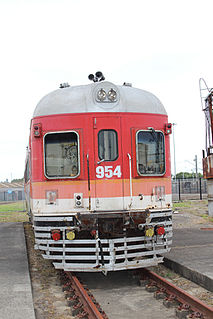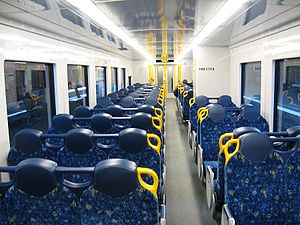
The T sets, also referred to as the Tangara trains is a class of electric multiple unit operated by Sydney Trains in Sydney, Australia. The Tangaras were delivered between 1988 and 1995, and are third-generation trains.

The British Rail Class 185 Desiro units are a diesel multiple-unit (DMU) passenger train of the Desiro UK family built by Siemens in Germany for the train operating company First TransPennine Express. They are currently operated by TransPennine Express.

The Hunter Line is a NSW TrainLink passenger train service that operates from Newcastle to Dungog and Scone in the New South Wales Hunter Region. It operates on the Newcastle, Main North and North Coast lines.

The Endeavour is a diesel multiple unit train operated by NSW TrainLink on passenger rail services in New South Wales, Australia on the Hunter Valley, Main Western, Southern Highlands and Illawarra lines. They are mechanically identical to the Xplorers. All 30 carriages were built by ABB Transportation in Dandenong, Victoria.
UGL Rail is an Australian rail company specialising in building, maintaining and refurbishing diesel locomotives, diesel and electric multiple units and freight wagons. It is a subsidiary of UGL Limited and is based in Melbourne, with a staff of 1,200 across Australia and Asia. It operates factories in Broadmeadow, Maintrain Auburn, Spotswood and Bassendean. While it used to operate a factory in Taree, the plant has currently shut down and the equipment sold off.

The NSW TrainLink H set, or OSCAR, is a class of electric multiple unit built by UGL Rail, Broadmeadow for NSW TrainLink in New South Wales, Australia. They are operated by NSW TrainLink. These sets operate services from Sydney to Newcastle, Kiama and Springwood. The first entered service in December 2006 and the last in December 2012. They are formed into 55 four-carriage sets.

The 620/720 class railcars were a class of Diesel Multiple Unit built by the New South Wales Government Railways and operated from 1961 until 2007.
The railways of New South Wales, Australia, use a large variety of passenger and freight rolling stock.

The Xplorer is a diesel multiple unit train operated by NSW TrainLink on regional rail services in New South Wales from Sydney to Armidale, Moree, Broken Hill, Griffith and Canberra. The first Xplorers entered service in October 1993, and are mechanically identical to but feature a higher level of passenger amenity than the Endeavour railcars. All 23 carriages were built by ABB Transportation in Dandenong, Victoria.

The Silver City Comet was a train service that operated from September 1937 until November 1989 between Parkes and Broken Hill in western New South Wales. It was the first air-conditioned train in Australia.

The DRC was a class of railmotor operated by the Victorian Railways on its country rail network in Victoria, Australia. The cars were built by Tulloch Limited in New South Wales, and featured aluminium and steel construction, air-conditioning, and twin diesel engines with hydraulic transmissions.

The 900/800 class railcars were Diesel Multiple Units built by the New South Wales Government Railways between November 1951 and November 1960.

The 600/700 class railcars were a class of Diesel Multiple Unit built by the New South Wales Government Railways. They were built to operate on branch lines from 1949 with low traffic volumes later being transferred to Newcastle and Wollongong to operate suburban services until withdrawn in 1994. However, one 600 class railcar was converted to solar operation for use on the Byron Bay Train service. The upgraded train entered service on 16 December 2017 and is believed to be the world's first solar-powered train.
The 660 & 760 Class railcars are a Diesel Multiple Unit train built by the New South Wales Government Railways (NSWGR) and used in the latter stages of their life by CityRail, primarily on its Hunter Valley line. The trains have since been phased out in favour of the newer Endeavour railcar model. The 660/760 railcars were converted by NSWGR from earlier 600/700 Class vehicles between 1973 and 1975.
The RUB type carriage stock was a type of steel bodied air conditioned passenger carriage operated by the New South Wales Government Railways from September 1949 until April 2000.
The 1100 class railcar or Budd railcar are a type of diesel railcar built by Commonwealth Engineering for the New South Wales Government Railways in 1961. They primarily operated on the South Coast Daylight Express until withdrawn in 1993.

NSW TrainLink is an Australian coach and train operator providing services throughout New South Wales and into the Australian Capital Territory. It also operates some interstate services to Victoria, Queensland and South Australia. It is the operating name of NSW Trains, an agency of Transport for NSW.
The NSW TrainLink fleet of trains serves the areas outside Sydney, Australia, mainly interurban and interstate lines. The NSW TrainLink fleet consists of both diesel and electric traction, with the oldest of the fleet being the V sets and the youngest being the H sets.

The WAGR WCA class railcars and WCE class trailers were built by Comeng, Granville for the Western Australian Government Railways in 1971 to operate the new Prospector service between East Perth and Kalgoorlie. At the time of their construction the WCA class units were the longest and fastest diesel railcars in the world.

The NSW TrainLink D sets are a class of 554 new carriages being built to replace NSW TrainLink's Intercity electric multiple unit fleet, replacing the entire V set fleet and allowing the H sets to be reallocated to Sydney suburban services. The trains will operate on services from Sydney to Newcastle, Lithgow and Kiama. The first trains were delivered in December 2019, and will enter service in 2020.

























